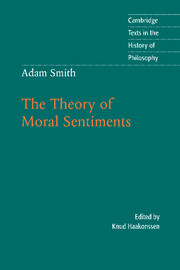Book contents
- Frontmatter
- Contents
- Introduction
- Chronology
- Further reading
- Note on the text
- Abbreviations
- The Theory of Moral Sentiments
- Advertisement
- Contents
- Part I Of the propriety of action
- Part II Of merit and demerit; or, of the objects of reward and punishment
- Part III Of the foundation of our judgments concerning our own sentiments and conduct, and of the sense of duty
- Part IV Of the effect of utility upon the sentiment of approbation
- Part V Of the influence of custom and fashion upon the sentiments of moral approbation and disapprobation
- Part VI Of the character of virtue
- Part VII Of systems of moral philosophy
- Index
- Cambridge texts in the history of philosophy
Advertisement
Published online by Cambridge University Press: 05 June 2012
- Frontmatter
- Contents
- Introduction
- Chronology
- Further reading
- Note on the text
- Abbreviations
- The Theory of Moral Sentiments
- Advertisement
- Contents
- Part I Of the propriety of action
- Part II Of merit and demerit; or, of the objects of reward and punishment
- Part III Of the foundation of our judgments concerning our own sentiments and conduct, and of the sense of duty
- Part IV Of the effect of utility upon the sentiment of approbation
- Part V Of the influence of custom and fashion upon the sentiments of moral approbation and disapprobation
- Part VI Of the character of virtue
- Part VII Of systems of moral philosophy
- Index
- Cambridge texts in the history of philosophy
Summary
1 Since the first publication of The Theory of Moral Sentiments, which was so long ago as the beginning of the year 1759, several corrections, and a good many illustrations of the doctrines contained in it, have occurred to me. But the various occupations in which the different accidents of my life necessarily involved me, have till now prevented me from revising this work with the care and attention which I always intended. The reader will find the principal alterations which I have made in this New Edition, in the last Chapter of the third Section of Part First; and in the four first Chapters of Part Third. Part Sixth, as it stands in this New Edition, is altogether new. In Part Seventh, I have brought together the greater part of the different passages concerning the Stoical Philosophy, which, in the former Editions, had been scattered about in different parts of the work. I have likewise endeavoured to explain more fully, and examine more distinctly, some of the doctrines of that famous sect. In the fourth and last Section of the same Part, I have thrown together a few additional observations concerning the duty and principle of veracity. There are, besides, in other parts of the work, a few other alterations and corrections of no great moment.
2 In the last paragraph of the first Edition of the present work, I said, that I should in another discourse endeavour to give an account of the general principles of law and government, and of the different revolutions which they had undergone in the different ages and periods of society; not only in what concerns justice, but in what concerns police, revenue, and arms, and whatever else is the object of law.
- Type
- Chapter
- Information
- Adam Smith: The Theory of Moral Sentiments , pp. 3 - 4Publisher: Cambridge University PressPrint publication year: 2002



